Democracy gets a facelift
October 23, 2014
Envisioning a future that would make the founding fathers proud, Los Angeles County is investing $13.6 million to revolutionize its voting system and possibly set the standard for the rest of the country, too.
After decades of putting up with the clunky InkaVote and its even clunkier predecessors — Votomatic punch cards, anyone? — the Board of Supervisors voted Tuesday to develop a prototype with a touch screen and other high-tech innovations designed to serve the different needs of the county’s nearly 5 million registered voters.
Barring any serious glitches, the new “ballot marking machine” will be field tested in 2017 and mass produced in 2018, in time for the gubernatorial election.
“If this works well in L.A. County, it could be a game changer for the nation,” said Pamela Smith, president of Verified Voting, a nonpartisan organization that advocates election accuracy, transparency and verifiability.
Registrar-Recorder/County Clerk Dean Logan said the machine’s engineering specifications, intellectual property and functional prototypes would be nonproprietary and remain in the public domain.
“From the beginning, we’ve adopted the principle of doing this in a very transparent manner so other jurisdictions can take advantage of the data,” he said.
The project’s first priority is to upgrade the county’s voting system but Logan added, “If we can do that in a way that is transferrable to other jurisdictions, that can advance voting systems across the country, it would be icing on the cake.”
It may not have a catchy name, but the proposed new voting system is state-of-the-art, sophisticated and intuitive.
The touch screen can be customized to display foreign languages, larger fonts and high-contrast backgrounds. Voters can also select candidates by pressing buttons on an attached handheld device.
Other advanced features include the ability to process voice command and to “read” interactive sample ballots on smartphones. Voters would simply hold their smartphones over the scanner, and the names of their pre-selected candidates would appear on the touch screen to be printed on the official ballot.
The machine also would allow ballots to be cast in conveniently located “voting centers” over an extended period of time, instead of in a specific polling place and only on Election Day. It would print the names of the candidates on the ballot, so poll workers would not have to interpret marks like on the InkaVote.
“This is a critical needs project because the environment and demands under which the county administers elections have become increasingly complex, challenged by a growing and diverse electorate, an aging voting system, and a fluid regulatory environment that has limited the development of voting systems,” Logan said.
InkaVote has been in use only since 2003 but its vote-counting system was based on a program developed in 1968—that’s 46 years ago, when the Vietnam War was still raging, Lyndon Johnson was in the White House and the original Star Trek was on the television.
“It has become increasingly difficult for the registrar/recorder to source replacement hardware, as well as for staff to support its outdated technology,” said a recent analysis by county Chief Information Officer Richard Sanchez. “(And) the lack of system flexibility places the county at risk of noncompliance of election requirements.”
The county launched the Voting Systems Assessment Project in 2009 and began consulting with technology, security and elections experts, as well as different kinds of voters to determine what upgrades were necessary.
When none of the existing off-the-shelf voting systems were found capable of meeting the county’s complex needs, the prominent design and innovation consultancy firm IDEO was recruited to develop a prototype.
The firm’s name may not be familiar to most but its work certainly is. IDEO helped design Apple’s first computer mouse, Crest’s standup toothpaste tube, and TiVo’s thumbs up and thumbs down buttons.
IDEO Director Blaise Bertrand said he hopes the “human centered design” of the new voting system will boost turnout at the polls.
“We tried to improve the voter experience by understanding the voters’ needs and providing a solid technology platform,” he said. “We hope it will make people more engaged.”
Still, not everyone was impressed by the changes. David Holtzman, founder of Los Angeles Voters for Instant Runoff Elections, sought to delay the project. “There’s no pressing need now for a new system,” he told the board, “unless you want to provide for improved election methods like using ranked choice voting to have instant runoff elections.”
Ranked choice voting would allow voters in a primary election to identify their favorite candidates in order of preference, which would eliminate the need for a runoff election.
Given the rapid pace of technological advances, there are worries the new voting machines would be rendered obsolete when, say, online voting becomes a reality. Logan, however, believes that may be years or even decades away
“In order to have a truly online or paperless voting system, you have to get over the barrier of the secret ballot,” he explained.
“When you bank online, for example, and somebody hacks into the system, it can be corrected because you and the bank both know what should be in the account,” he added. “With voting, it doesn’t work that way. Once you put that ballot into the ballot box, we’re not supposed to know your identity, so tracking mistakes would be difficult.”
Smith said the importance of having secured voting systems cannot be overstated.
“It’s participation in our democracy, the peaceful transfer of power,” she said. “To have an obscure, opaque voting system that nobody understands just doesn’t make sense.”
“Voting systems need features that would provide us with justifiable confidence that election outcomes are correct,” she added. “It’s not enough for those running the elections to say, ‘Just trust us, it’s working.’ ”
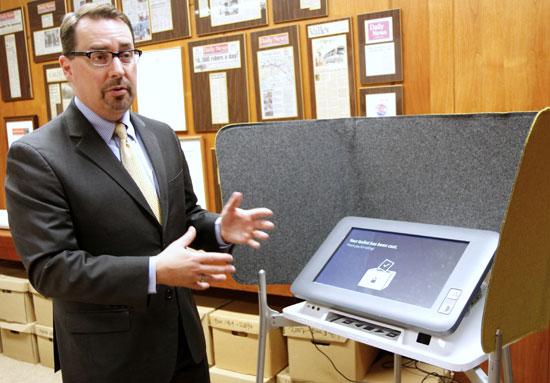
Registrar-Recorder Dean Logan says the new system will help the county deal with an increasingly complex electorate.
Posted 10/23/14
Up a tree and loving it
October 16, 2014
Michell Sanchez was only a teenager at the time, but she came of age as an environmentalist when TreePeople first walked onto her high school campus more than a decade ago.
Sanchez was an early—and enthusiastic—participant in Generation Earth, a hands-on environmental education program sponsored by the Los Angeles County Department of Public Works and carried out by TreePeople in local middle schools and high schools since 1998. Funding for the next two years, with renewals possible for 4½ years after that, was approved this week by the Board of Supervisors. The investment—which could total $4.35 million over the life of the current contract—promises results that go well beyond the classroom.
Just ask Sanchez.
Not only did the program inspire her to help lead a team of Grant High School students to launch an on-campus recycling program—and later to create a native plants butterfly garden that still flourishes at the school—but it also influenced what she went on to study in college. (She received her degree in environmental science and policy from Cal State Long Beach.)
Now 25, Sanchez works for TreePeople as a development associate and doesn’t hesitate to sing the praises of the program that got her started.
Generation Earth, she says, left her feeling “empowered and inspired.”
“It really helped guide me to what I wanted to do,” Sanchez says.
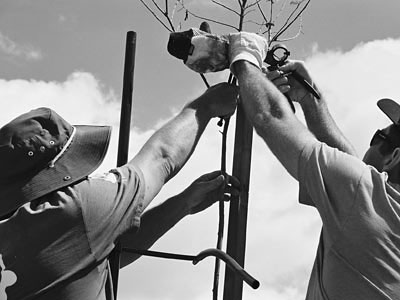
Students strenghten a just-planted tree as part of the Generation Earth program, which has been going strong since 1998.
Sanchez is among the hundreds of thousands of high school and middle school students who have taken part in Generation Earth since the program started. In just the past seven fiscal years, 228,188 students created 2,697 projects at 244 schools.
While Sanchez worked on recycling and gardening, other student endeavors over the years have ranged from e-waste collection events to an urban runoff audit whose results were publicized via social media.
“It’s basically to inspire the students to take personal responsibility about the environment, and then transforming that into action by doing a service-learning project on campus,” says Edna Gandarilla, who manages the program for Public Works.
Some of those actions can have an enduring impact. Diamond Bar students, for example, convinced school district officials to install water-efficient sprinklers at their high school. “They noticed that when the sprinklers were on, they were watering the sidewalks and they were just wasting a lot of water,” Gandarilla says.
Candice Russell, TreePeople’s director of environmental education, says her group’s partnership with Public Works represents a “wonderful symbiosis” that is unparalleled anywhere else in the state.
“This is a very unique program,” Russell says. “It’s a beautiful marriage between TreePeople’s mission—to inspire the people of Los Angeles to take personal responsibility for the urban forest—and the county’s goal of educating the students of Los Angeles.”
It’s also a good barometer of which environmental issues seem most pressing to the younger generation.
“People are fascinated by water, especially because of the drought. It’s huge,” Russell says. “In addition to that, school greening. They want green campuses. They want healthy, viable, green campuses and they want to have a part in making it.”
Waste issues and stormwater solutions also get lots of attention, in part because of two popular contests that pit schools against each other in friendly competition each year. “Battle of the Schools” is a pounds-of-recycling-per-student smackdown, while “Streets to the Sea” showcases student media messaging campaigns about stormwater.
Secondary school students aren’t the only ones getting some environmental consciousness-raising. A second DPW-sponsored program, called Environmental Defenders, stages elementary school assemblies starring actors who play characters extolling the virtues of the Four Rs. (Those would be Rethink, Reuse, Reduce and Recycle.)
As a practical matter, such educational efforts help the county keep up with state mandates to reduce the amount of trash going into landfills, while also spreading a multi-faceted environmental message to a large and growing audience.
Because it turns out that what happens at school doesn’t stay at school.
Students are “great influencers of their parents,” said Public Works spokesman Kerjon Lee. “We’ll have kids going home and telling their parents not to take longer than 5-minute showers. They’re great messengers for us.
“At that age, we know they’re still open to adjusting their own behaviors. And they also feel really good about having an impact. Basically, we’re training young people on how to be better citizens, not just better environmental stewards.”
Posted 10/16/14
Green river milestone
July 10, 2014
Improving the Los Angeles River has become a local cause célèbre, with increasing numbers of Angelenos pushing to transform the concrete channel into a place where people can exercise, play and relax.
This Saturday, L.A. County takes a big step toward that goal when it opens the L.A. River Headwaters Project, which is located at the river’s official beginning—the convergence of Calabasas and Bell creeks in Canoga Park.
The $11.5 million project is the river’s largest greenway improvement so far, with 2.5 miles of upgrades that benefit the public and the environment. Cung Nguyen, the river’s watershed manager for the Department of Public Works, said the opening is an important milestone.
“If we improve the beginning and end of the river, then we can start filling in all the gaps,” Nguyen said. “Ultimately, the grand picture is to provide connectivity for recreation along the whole river.”
Joggers and bicyclists will gain access to 2.5 miles of new trails (1¼-mile in each direction) on which to ride and run, passing safely under street crossings and over pedestrian bridges. Rest areas with benches will provide pit stops for those who prefer to take a slower pace.
Native landscaping replaces the former backdrop of an access road and chain link fencing. It also creates new habitat for wildlife, including 300 species of migratory birds that rest their wings by the river. Maintenance crews have been trained to know when nesting seasons are so they won’t disturb the avian guests as they pass through.
The project is still designed to help prevent devastating floods while reducing the amount of urban runoff with bioswales—subsurface plant and sediment-filled structures that let water seep into the ground to be filtered naturally rather than getting fast-tracked, pollutants and all, into the ocean. Nguyen estimated that up to 587,000 gallons of water will be recaptured in an average year.
The headwaters project is funded by the county Flood Control District, along with a $1.8 million grant from Prop. 84, a state initiative dedicated to improving water systems. The project originated with the 1996 L.A. River Master Plan, which recognized the waterway’s importance as a natural resource and targeted publicly-owned lands for future projects. More than 50 of those projects have been completed to date, with another 50 or so to come. Coming up are more greenways like the headwaters project as well as things like wetlands, parks, bike paths and kayaking programs. Just last month, another San Fernando Valley greenway, the half-mile Valleyheart Riverwalk project, opened between Studio City and Sherman Oaks.
While those project-by-project efforts continue, a $1 billion revitalization plan approved by the Army Corps of Engineers in May is expected to drastically improve a sweeping 11-mile section of the river between downtown L.A. and Elysian Park.
But every piece matters; even after the entire river is revitalized, few people will use all 51 miles of it in a single day. The local community of Canoga Park stands to benefit most from the headwaters project, something that Luis Rodriguez, principal of Canoga Park High School, is keenly aware of. His school sits just west of the headwaters. He sees a great educational opportunity for his students, who have been focusing on topics like water conservation and drought-resistant plants in the context of one of California’s most severe water shortages on record.
“For our school it makes a huge difference, but it’s going to revamp the entire community in a positive way,” Rodriguez said. “There’s so much industry in our area, but living spaces where people can have fun? That’s something that is really needed.”
The official opening ceremony takes place at 11 a.m. on Saturday, July 12, at DeSoto Avenue and the Los Angeles River in Canoga Park, 91303.
Posted 7/10/14
The L.A. River’s stormy past
June 5, 2014

After pounding storms in 1938 brought death and destruction, the river would be tamed with concrete.
For decades, the Los Angeles River has been ridiculed across the country as being as fake as a Botox brow, maligned in its own backyard as nothing more than a 51-mile concrete eyesore. But the river’s image is about to undergo a game-changing makeover, thanks to the Army Corps of Engineers’ recent endorsement of a $1 billion revitalization plan, which more than doubled an earlier recommendation.
The plan to transform an 11-mile stretch of the river from Griffith Park to downtown L.A. is intended to give people of all ages a healthy urban getaway, where they can relax and play. But back in the days when the river was first encased in concrete in one of the nation’s largest Depression-era public works projects, the federal government’s investment was about much more than improving lives. It was about saving them.
The unpredictable waterway had killed hundreds of people during a series of storms that had repeatedly devastated the region over the previous half-century. Two particularly vicious wallops in the 1930s forced local officials to seek federal help. The first, in 1934, killed dozens of people in a watery siege witnessed by folk songwriter and poet Woody Guthrie, who memorialized it in The Los Angeles New Year’s Flood:
Whilst we all celebrated
That happy New Year’s Eve,
We knew not in the morning
This whole wide world would grieve;
The waters filled our canyons
And down our mountains rolled;
That sad news rocked our nation
As of this flood it told.
No, you could not see it coming
Till through our town it rolled;
One hundred souls were taken
In that fatal New Year’s flood.
But it was the urgency generated by a second deadly storm, this one in 1938, which brought the biggest infusion of federal dollars through the New Deal’s Works Progress Administration to protect the safety of one of America’s fastest growing regions. Between February 27 and March 3 of that year, Los Angeles, Orange and Riverside counties were drenched by more than 10 inches of rain. The river jumped its banks and flooded a third of the city, killing 115 people, while destroying or damaging more than 6,000 homes. Total property damage was about $1.44 billion in today’s dollars. (See video footage of the flood here.)
The Los Angeles County Flood Control District, overseen by the Army Corps of Engineers, put 17,000 people to work on the job at the height of the Great Depression. Almost all of the work was done by hand. They moved 20 million cubic yards of earth, poured 2 million cubic yards of concrete, laid 150 million pounds of steel and set 460,000 tons of stone. The entire length of the L.A. River was channelized, along with 147 miles of tributary channeling. Also built were 5 flood control basins and 316 bridges.
The transformation of the river took 20 years to complete.
By the time it was finished, the L.A. River was unrecognizable from its natural state. About 90% of it had been lined with concrete along its sides and bottom. A natural riverbed was kept for the remaining 10%. Formerly a home for frogs, fish and birds, the river became a graffiti-scarred channel for urban runoff and garbage, sending pollutants of various sorts speeding towards the sea. It was immortalized in movies like Grease and mocked by comedian Conan O’Brien.
It was, in short, a river in name only—a reputation that restoration leaders are now determined to change, while maintaining the river’s ability to control flood waters.
In addition to the billion-dollar revitalization project, there are ongoing efforts to build a continuous 50-mile bike path and greenway along the river. Last summer, a pilot kayaking program was launched in the Elysian Park neighborhood. Based on its success, the L.A. City Council voted in February to make the program permanent, while expanding it to another section of the river, the Sepulveda Basin.
So for now, although the history of the L.A. River is still being written, a new chapter has opened.
Posted 6/5/14
Art that keeps it clean in Malibu
April 17, 2014
Few Malibu visitors look to the city’s storm drains for inspirational scenery. But those mundane slots under the curb have a big job that’s crying out for a little artistic appreciation.
Now it’s getting some. This week, four colorful street murals will be unveiled at storm drains throughout the coastal city, designed and painted by Lindsay Carron, a local artist known for her activism in ecological causes.
The on-the-ground depictions of sea life and rain gardens are part of an ongoing campaign to remind passersby that what falls onto the streets washes into the ocean.
“We needed to communicate this message about protecting areas of environmental significance from urban runoff, and we had already tried the traditional outreach campaigns and typical marketing strategies,” says Casey Zweig, coastal preservation specialist with the city.
“So we thought public art might be something that would grab people and interrupt their regular routine.”
The message is critical along the Malibu coastline, which supports such a diversity of marine life that the state has designated it as one of 34 Areas of Special Biological Significance. The designation, conferred by the state Water Resources Control Board, carries heightened environmental restrictions, particularly on runoff.
From Latigo Point to Laguna Point near Point Mugu, nothing but pure, clean rainwater is supposed to be discharged into the ocean. That means locals have to be constantly vigilant about the ways in which inland pollution can inadvertently be washed down the storm drains and into the water—lawn chemicals that can be carried to the beach on water from a broken sprinkler, for instance. Or soapy, oily water that can flow into the drain when a car is washed curbside. Or the mountains of plastic bags and cigarette butts and foam cups that course down the drains and into the seaweed every time it rains.
The city has come at the problem from a number of angles, ranging from education and outreach to facilities designed to catch and treat runoff before it reaches the beach. Underground biofiltration systems are being built into the natural topography at Wildlife Road and Broad Beach Road to capture and cleanse urban runoff. At Pacific Coast Highway and Cross Creek Road, a vacant lot has been turned into a 15-acre park that doubles as another state-of-the-art runoff cleaning machine. Yet another city program encourages locals to convert traditional landscapes to ocean-friendly rain gardens.
Zweig says the “Keep It Clean, Malibu” public art gambit was among the last to be funded by a 2½-year state grant that the city received to pay for education and outreach, and was inspired by a similar storm drain project in Reno. With approval from the City Council, the city’s Cultural Arts Commission put out a call in February for artists to create art around storm drain inlets at Point Dume Shopping Center, Trancas Park, Cross Creek Road and the corner of Morning View Drive and Philip Avenue.
That call caught the attention of Deborah Collodel, a local art lover who immediately thought of Carron, whose work she had discovered several years ago during a spur-of-the-moment visit to the campus gallery at Carron’s alma mater, Pepperdine University.
“They were looking for a muralist and she immediately came to mind because she has done so much work that combines art with awareness,” Collodel says, adding that she and her husband collect Carron’s work, and have hung it at the Malibu Motel, their local business.
Carron’s activist art ranges from murals in Skid Row and Baja to detailed pen-and-ink renderings of wolves for the California Wolf Center. Now 24 and living in Culver City, Carron says she rushed to meet the entry deadline as soon as her friend called her.
“Mural work is a fantastic way to reach people who wouldn’t necessarily be interested in art, or involved in the art realm,” she says. “And I knew this project would give me the chance to connect with the community.”
Her winning design beat out 17 other contenders for the $3,200 commission, depicting not only what’s at stake—the well-being of Malibu’s dolphins, sharks, sea lions and other marine life—but also a potential solution: drought tolerant rain gardens full of rocks, succulents and colorful wildflowers. The seascapes cover the concrete mouths of the storm drains, while the rain gardens decorate the area above the curb.
Though the official ribbon cutting was set for this week at the project’s Trancas Park location, Carron and the city’s Zweig say they already have gotten positive feedback, not only about the murals but about their theme.
“I did a little research into urban runoff, and wanted to say, OK, what can we do to prevent this,” Carron says. “Rain gardens take in excess water from rain or car washing or dumping, and filter it through the soil, where it can be used by plants instead of draining it into a storm drain. It’s a buffer. I liked the idea because it’s not only simple, but also beautiful.”
Posted 4/17/14
New sheriff writes a new chapter
April 17, 2014
When former Sheriff Lee Baca announced his surprise resignation to a crush of reporters in January, he closed with a heartfelt recitation of the agency’s “core values.”
“As a leader of the Los Angeles County Sheriff’s Department,” he said, his voice wavering with emotion, “I commit myself to perform my duties with respect for the dignity of all people, integrity to do right and fight wrongs, wisdom to apply common sense and fairness in all I do, and courage to stand against racism, sexism, anti-Semitism, homophobia, and bigotry in all its forms.”
It was not the first time the sheriff had publicly, solemnly recited the code. He’d long ago committed the words to memory and had spoken them often during the ups and downs of his tenure—especially during those final months when he and his department were under siege for alleged deputy brutality in the jails.
But now Baca is gone. And so, too, is his code of core values.
On Monday, interim Sheriff John Scott sent out an all-hands email announcing the creation of a new statement, one containing “the same deeply-held values” but expressed in a new way. Scott explained that he’d reached out to a committee of deputies, sergeants and professional staffers to craft the new statement, with its extra emphasis on professionalism, compassion and accountability—words that were absent in Baca’s code.
“I will hold myself accountable for serving our Department and the public in a manner consistent with these values, and I will, in the same way, hold each of you accountable for your actions,” Scott pledged in his department-wide email.
What went unsaid was the subtext. Many in the rank-and-file had come to view the old code as a collection of empty vows, violated by some at the top of the organization, Scott explained in an interview.
The old code had become an example of, “do as I say, not as I do,” Scott said. “That was the driving force [behind the change]. The code should not be just nice words on a wall. It should reflect values you live by in the light of day and in the shadows of darkness.”
The new code was built around six words (one for each point of the badge) that the 12-member committee concluded best described how department members should conduct themselves in the pursuit of their mission, Scott said. Those words were then woven into this short statement:
“With integrity, compassion, and courage, we serve our communities—protecting life and property, being diligent and professional in our acts and deeds, holding ourselves and each other accountable for our actions at all times, while respecting the dignity and rights of all [emphasis included].”
Beyond its statement of guiding principles, the new code also is meant to send a broader symbolic message.
Since his temporary appointment by the Board of Supervisors in late January, Scott has wasted no time dismantling remnants of the Baca Administration that he believes had damaged morale, undermined the department’s effectiveness and broken the public’s trust.
Among other things, he’s shaken up the management ranks, created new internal controls and even banned cigar smoking on a patio at the agency’s Monterey Park headquarters that was frequented by friends of the top brass and had come to represent clubbiness and exclusion.
These actions, like the rewritten statement of core values, will let the troops and the communities they serve know that “this is a new beginning,” said Scott.
Scott has said he wanted to institute these kinds of changes nine years ago, while serving in the department’s command staff. But unable to get Baca’s buy-in, Scott said, he retired in 2005, later becoming the No. 2 official in the Orange County Sheriff’s Department, where he has led reform efforts in that once-troubled agency.
As part of Scott’s deal with the Board of Supervisors, he’ll return to Orange County after voters here elect a new sheriff either in the June primary or a November runoff. The board did not want an interim sheriff to be distracted by a divisive political campaign at a time when the department needed clear, focused direction.
The day after his appointment, Scott said, he shared a private meal with Baca to talk about the future of a department to which both had devoted decades of their lives.
“I told him, ‘There’s going to be some things I do and it’s going to be sensitive to you. It’s not personal. It’s not about me, it’s not about you. It’s about the department.’ ”
Posted 4/17/14
A new Dawn at the museum
April 16, 2014

After overseeing high-visibility projects all over the county, Dawn McDivitt is ready for a new challenge.
Want to explore the Dawn McDivitt map of Los Angeles?
Here’s an itinerary, just for starters:
A gleaming architectural gem (Disney Hall), an international symbol of great music (the Hollywood Bowl shell), a splashy Civic Center hot spot (Grand Park), a state-of-the-art medical facility (LAC+USC Medical Center), an imposing lockup on the outskirts of downtown (Twin Towers Jail), even a tarry pond right beside Wilshire Boulevard, complete with prehistoric mammoth figures (the La Brea Tar Pits lake bed.)
Over more than two decades, McDivitt has managed projects to build, rebuild or revamp all of those, along with numerous other L.A. County facilities ranging from fire stations to swimming pools. It’s an extensive body of work that has served untold tens of thousands of residents and visitors from every walk of life.
While her pivotal role in bringing all those projects to fruition may be little known to the general public, around the county Hall of Administration, McDivitt is something of a capital projects rock star, with her exuberant laugh, infectious enthusiasm (a favorite adjective: “fabulous!”) and widely-respected ability to get things done.
But, after helping guide the course of more than $2 billion in projects as a manager in the Chief Executive Office, the 56-year-old McDivitt is about to notch a new destination on her professional map: the county’s venerable Natural History Museum.
On May 1, she becomes the museum’s chief deputy director, serving as its No. 2 executive under president and director Jane Pisano.
“She has worked on so many major cultural projects in the county. She really understands and values public-private partnerships and getting things done,” Pisano said. “She is going to be such a great fit here.”
In addition to the main museum in Exposition Park, McDivitt in her new position also will oversee the Page Museum at the La Brea Tar Pits and the William S. Hart Ranch and Museum in Newhall.
“For me, it’s a time for something new, and moving outside of the comfort zone,” McDivitt said on a recent sunny afternoon as she left her 7th floor office to walk through one of her signature accomplishments, Grand Park. “Especially when you stop and realize you’ve been in a place for 20 years.”
The attraction—and the challenge—will be learning to lead a new team in a new environment with a lot of new responsibilities, from human resources to technology, along with more familiar duties like overseeing projects.
“I’m looking forward to learning…I always thrive on knowledge, anyway. I think if you continue to learn, you continue to expand as a person,” McDivitt said. Plus, she added: “I think it’s going to be a really cool environment to work down there because I absolutely love history.”
Like many Angelenos, McDivitt has early memories of going to the Natural History Museum and the Page as a child. And in her professional capacity, she got the chance to oversee a challenging project on the Page/Tar Pits grounds in 2011 when it turned out that the lake was seeping oil and gas into storm drains when it overflowed.
She supervised the CEO’s staff in managing the effort to install a new underground water purification system and connect the tar pits lake to the city sewers beneath Wilshire Boulevard.
Fix-it operations are nothing new to McDivitt.
“It’s kind of like that little Dutch boy with his fingers in the dike,” she joked. “There are times that I just want to pull my finger out and see what happens!”
She’s kept trouble at bay countless times, perhaps most prominently when glare from the new Disney Hall was found to be reflecting into nearby condominiums and onto the street. The solution: Workers with hand orbitals sanded down part of the surface.
Then there was the discovery of human remains during construction of LA Plaza de Cultura y Artes. After expert consultation, the bodies and artifacts were reburied in a special memorial garden at the site.
Even Grand Park needed some emergency trouble-shooting after its inaugural event—a big participatory dance-fest—reduced the Performance Lawn to a “mud pit.” (A new underground drainage system is now in place to prevent a repeat performance.)
McDivitt said she has learned how to listen first and let solutions emerge from dialogue.
“Staying calm is a really good challenge to me since I’m Irish,” she said. “So I tend to want to react and solve a problem right off the bat, and think of a solution before I actually listen to everything. My sisters tend to say to me, ‘OK, I’m calling to talk to you and I only want you to listen. Don’t solve the problem. I want you to listen.’ “
McDivitt said she is leaving behind a “great team” to carry on the capital project work, including upcoming phases of the Grand Avenue Project. (A Frank Gehry-designed development to be built across from his acclaimed Disney Hall is expected to come before the Board of Supervisors later this month, before McDivitt departs.)
But she’ll be taking with her something rare and precious: the opportunity to watch in delight as her work took on a life of its own.
“Look how much it’s being used,” she said as she strolled through Grand Park, children frolicking in the fountain and grownups lingering over lattes at café tables. “This is fabulous! That just feels so exhilarating—especially when you’re in the public sector.”
Posted 4/16/14
Get ready for the slow lane on PCH
April 10, 2014
Pacific Coast Highway may be famed for its scenic vistas, but for locals, the real talk of the town is its construction zones.
“It’s a running joke here,” says 14-year resident P.J. Manney. “As soon as the tourists arrive, Caltrans shows up. This year, though, we’re actually a little freaked out.”
That’s because, beginning next week, traffic in Malibu and Santa Monica is expected to become extra congested for locals, commuters and sightseers, thanks to two long-term and several shorter-term public works projects along PCH.
The upshot? An already frustrating—and occasionally dangerous—stretch of one of America’s most storied highways is about to acquire even more roadblocks.
“The reasons are all positive, but getting there is going to be a real inconvenience,” sighs Elizabeth Anthony, who is bracing for a long, gridlocked summer near her home on Point Dume.
“I can’t say we shouldn’t have these projects, but for those who live out here, they’re a real concern.”
The roadwork arises from a variety of safety and environmental issues, and is being coordinated by the various jurisdictions. Among other measures to minimize the pain, officials plan to use “dynamic lanes” to ease traffic backups, creating more southbound lanes on PCH during morning rush hour, for instance, and more northbound lanes in the evening rush when commuters are heading home.
Still, locals say, PCH will be a slog. Among the projects:
- The second phase of the $9 million Coastal Interceptor Relief Sewer. This will shut down a 900-foot southbound stretch of PCH to expand sewer capacity between Chautauqua Boulevard and the Annenberg Community Beach House. Expected to start April 15, the year-long City of Los Angeles project will improve the capture of urban runoff that now runs directly into the ocean. The upgrade, financed by a bond measure, is necessary to meet federal water quality standards. Work will occur every day except on Sundays.
- A City of Santa Monica repair and repaving project around the California Incline, the slanted street that connects Ocean Avenue along the Santa Monica bluffs to PCH down below. Work will start in early September and is expected to continue at least through 2015.
- An assortment of safety-related City of Malibu projects, some of which have already begun. A particularly hazardous intersection at PCH and Big Rock Drive, for instance, will finally get a long-awaited left-turn signal, and a nearly 25-year-old “arrestor ramp” for runaway trucks is being improved at the Kanan Dume Road intersection with the coast.
Besides these big-ticket projects, “we’re also putting in a new, lit crosswalk at La Costa and doing a bike lane project from Busch Drive north to the northern city limits along PCH,” says Malibu Councilwoman Laura Zahn Rosenthal. Several bus stops also are being upgraded and traffic messaging will be improved.
Work is expected to be finished before summer, Rosenthal says, adding that the inconvenience ultimately will be worth it.
“That turning lane at Big Rock will make a big difference to the 240 homes up there,” she says. “We have bus stops right now that peoples’ legs actually hang over onto PCH if they sit on the bus bench. And we’ve been trying for a long time to make the Zuma Beach area safer.”
Cyclists say they are especially grateful for the Zuma Beach project, which will make it easier for bike traffic to get past the parked cars that often line the shoulder of the road on the beach side of the highway.
“There’s an area there that’s covered in ice plant and people park unevenly around it,” says Eric Bruins, planning and policy director of the Los Angeles County Bicycle Coalition. “So you’ll be going along and there’ll be five cars parked evenly along the shoreline and then one that’s haphazard. There are a lot of near misses that easily could become tragic if they aren’t fixed.”
In the meantime, however, Bruins says, his constituency, too, is bracing for even more PCH difficulties than usual.
“It’s already not for the faint of heart,” he says, noting that most motorists believe—incorrectly—that bicyclists are required to keep to the shoulder. Bruins says that, on PCH, that shoulder waxes and wanes, in part because of natural landslides and coastal erosion, so bicyclists frequently find themselves forced to merge with other traffic, which can be lethal.
Locals, meanwhile, say they’ll simply try to go with the slow-flow, though some predict their Westside coping skills will be challenged.
“Some of my friends are hunkering down in Malibu and will be working at home,” says Manney. “My husband’s offices are in Beverly Hills and Orange County, though.”
The family’s solution? “He’s going to start renting hotel rooms.”
Posted 4/10/14
Maximizing our “big gulp”
March 6, 2014
Here’s a factoid for those who think last week’s storms are water under the bridge now: Thanks to Los Angeles County’s flood control system, about $18 million worth of that rain is in the bank.
Los Angeles County Public Works Director Gail Farber reported this week that the county’s flood control infrastructure—sprawling, complex and generally taken for granted by Southern Californians—managed to collect and store some 18,000 acre-feet of rainfall by the time the skies cleared.
That’s enough water to supply 144,000 people for a year—roughly the population of Pasadena. Or, for Westsiders, a year’s worth of hydration for everyone in Santa Monica, the Pacific Palisades, Topanga Canyon and Malibu combined.
At about $1,000 per acre-foot for imported water, that’s good news, Farber told the Board of Supervisors on Tuesday. But in the midst of this drought, even more of that precious precipitation could have been saved had county dams not been clogged with dirt, sand and gravel from prior storms.
Instead, Farber said, water at Santa Anita Dam and Devil’s Gate Dam was released to maintain a safe capacity and prevent flooding.
“Had we more capacity behind our dams,” says Farber, “we could have captured more rain than we did.”
The storms dumped nearly a foot of rain last week on parts of Los Angeles County, raising water levels by as much as 36 feet at some of the county’s 14 dams. Though eagerly anticipated in this water-starved year, the rain also brought the threat of mudslides in foothill neighborhoods where brushfires have hit hard in recent months.
County workers had been out in force, working with surrounding municipalities and first responders to buttress vulnerable streets and help homeowners get ready, and were on hand round-the-clock as the storms hit.
Farber said the Department of Public Works alone “had more than 325 employees out there day and night, working 12-hour shifts in the pitch black with mud and debris flowing, and the rain coming down, and snow in the mountains, and hail sometimes.”
For all of that, the downpours scarcely made a dent in the three-year drought that has been withering the region, says Deputy DPW Director Massood Eftekhari.
“We’ve only accumulated 22 percent of what we normally accumulate, compared to prior years,” Eftekhari says. “We still have to conserve and collaborate to capture and utilize every drop we get.”
To that end, Public Works officials have been focused on maximizing the system’s capacity to better store rainwater when future storms hit. The county’s dams are set up not just to prevent rains from inundating neighborhoods in the flats and foothills, but also to collect storm water. That water later is released gradually onto massive spreading grounds where it percolates into the underground aquifers that supply about a third of L.A. County’s drinking water.
But each accumulation of rain also brings an accumulation of sediment and runoff. That sediment—hundreds of thousands of cubic yards of gunk in a typical year, enough to fill the Rose Bowl several times over—settles in dams and debris basins, and takes up space that otherwise would hold valuable rainfall.
Typically, that gunk gets trucked out over time by Public Works crews who dispose of it in designated “placement sites”, landfills and rock quarries—an epic task that, until recently, followed a time-honored schedule. After the historic 2009 Station Fire, however, so many tons of charred debris washed into the system that the county’s entire sediment management plan had to be recalculated, says Farber.
Now, she says, at least four county dams—Devil’s Gate, Big Tujunga, Pacoima and Cogswell—have been put on an accelerated sediment removal schedule. Devil’s Gate, which is near Pasadena, is first in line, with an environmental impact report already underway, and Pacoima will be soon to follow.
That intensified need to make room in the system has drawn some fire from neighborhoods near some of the dam sites. Though they have the most to lose should the clogged dams overflow, they also stand to suffer the greatest inconvenience from the truck traffic inherent in removing millions of cubic yards of muck.
As communities around the dams measure their risk against the potential for upheaval, the officials noted that the county will be working with state and federal agencies to come up with efficient ways to capture more storm water and prepare for future storms.
Meanwhile, they remind, this is no time to let our guard down.
“This was a good-sized gulp, but the drought still is not over,” Eftekhari says.
Posted 3/6/14





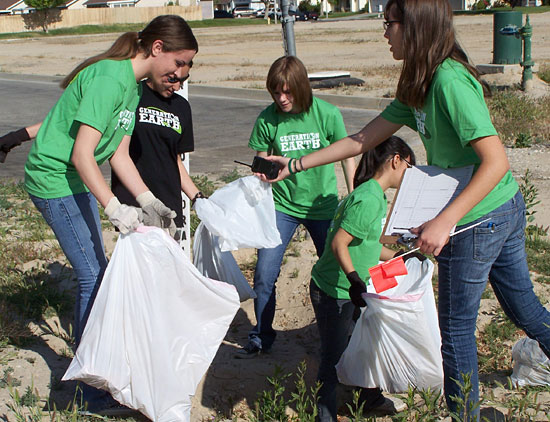

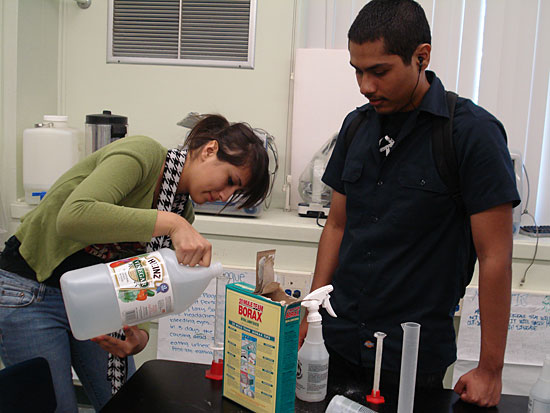
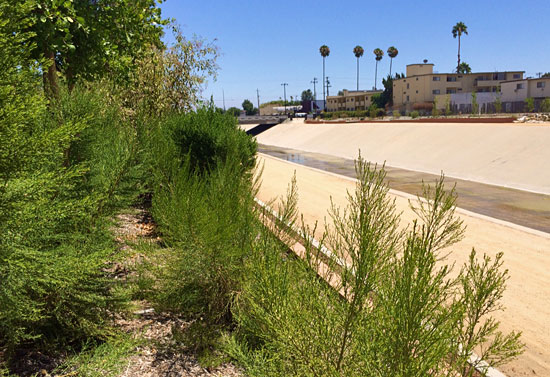
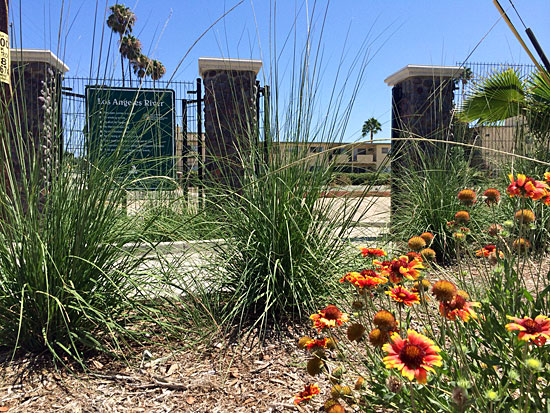
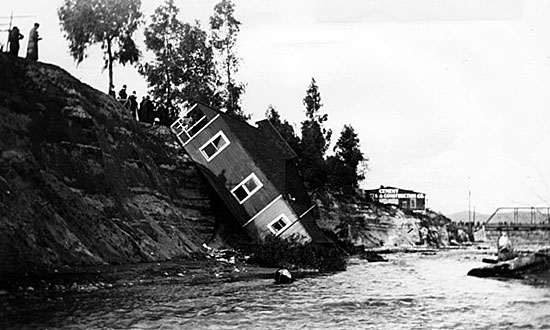
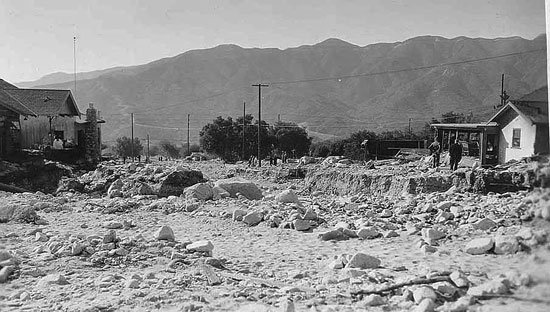
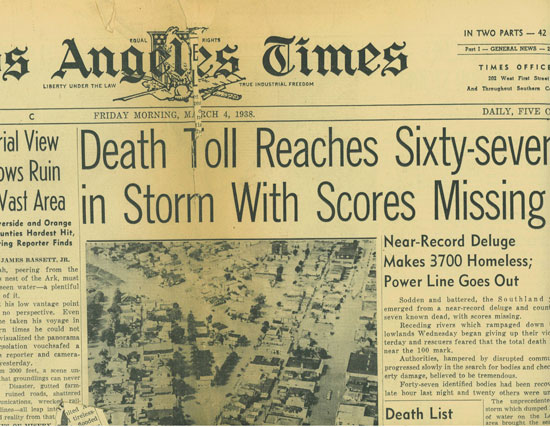
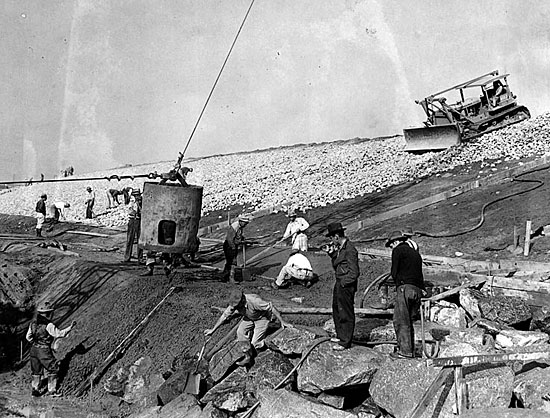
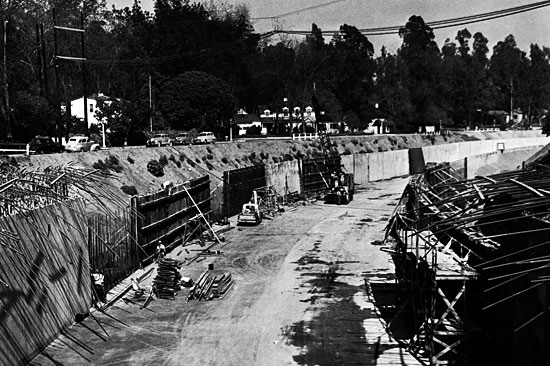
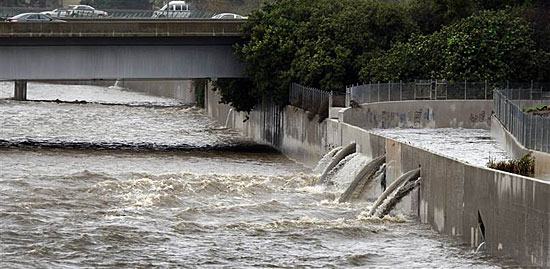
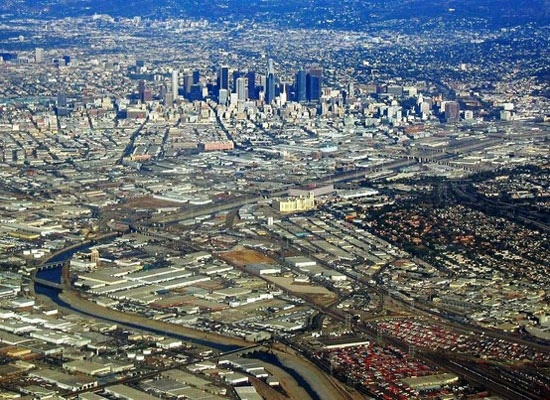
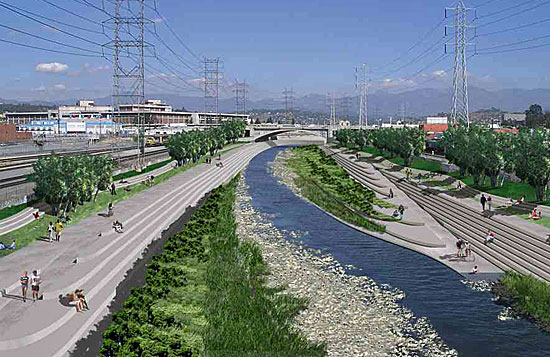



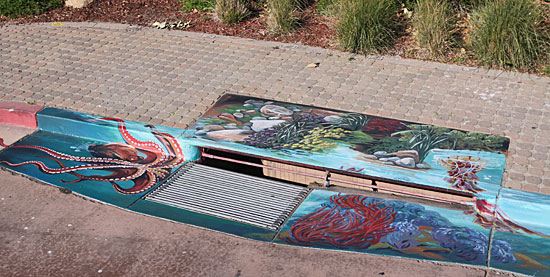
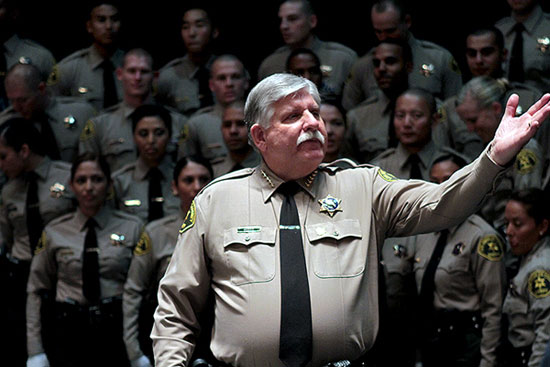

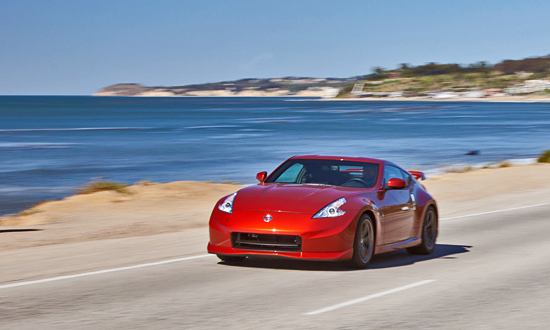
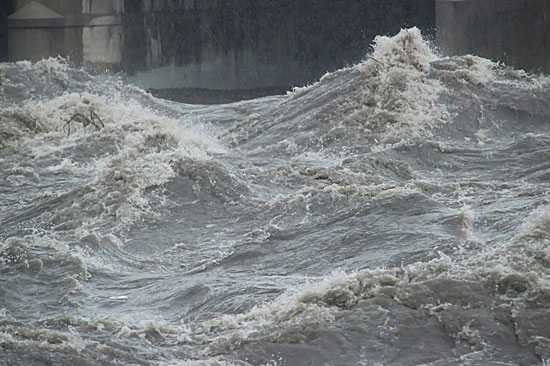
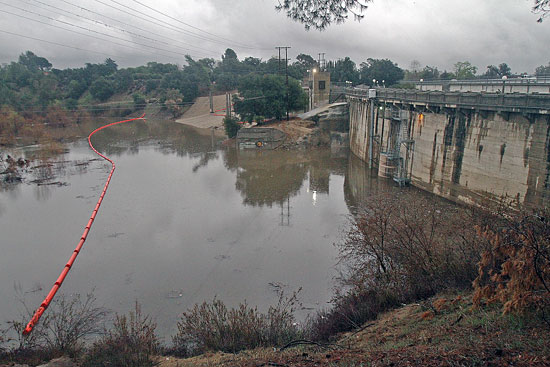







 405 bridge work causes a stink
405 bridge work causes a stink

